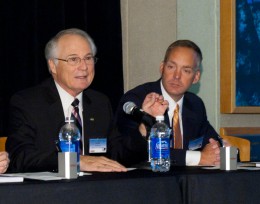
Wright State University President David R. Hopkins joined Dayton Development Coalition President and CEO Jeff Hoagland and other top leaders from the business, military and academic communities in the Dayton Business Journal’s fourth annual Defense Forum.
Wright State University is working to shift the paradigm of how it works with the Air Force and businesses in order to increase research in the Dayton region, speed technology commercialization and help grow the economy, President David R. Hopkins said to a gathering of community leaders today.
Hopkins joined other top leaders from the business, military and academic communities in the Dayton Business Journal’s fourth annual Defense Forum on Thursday, Dec. 1, at Sinclair Community College in Dayton. The panel discussed both the risks and opportunities to the region as Wright-Patterson Air Force Base faces the prospect of dramatic budget cuts in the coming years.
Wright State is developing innovative ways to capture more of the $4 billion in funded research that annually flows from the Air Force Research Laboratory (AFRL) at Wright-Patterson Air Force Base (WPAFB)—about double the total of all funded research by public and private universities and colleges in Ohio, Hopkins said.
Historically, only about five percent of AFRL’s research dollars stay in Ohio, Hopkins said. “We want to keep more of those research dollars” in the Dayton region, he said, because keeping intellectual capital in the region increases the chances of commercializing research locally and creating jobs.
Hopkins said the university’s Wright State Research Institute has formed the Human Performance Consortium, a team of 15 businesses and institutions, to create “a one-stop-shop right outside the fence” near WPAFB to capture AFRL research contracts that might otherwise have left the state. It has won multimillion-dollar contracts with AFRL and recently received state funds to accelerate workforce development for Ohio’s aerospace and defense industry.
Wright State also recently embedded a faculty member at Mound Laser & Photonics Center Inc. in Miamisburg in a cost-sharing agreement aimed at accelerating commercialization. Hopkins said the arrangement is unique but not unheard of. “It’s a very common concept in Germany, and yet you don’t see it happening here in the United States,” he said.
Hopkins also noted the work Wright State is doing in unmanned aerial vehicle (UAV) technology, both in human performance research and micro air vehicles, to help the Dayton region become a hub in UAV research and production.
Among other projects, Wright State has partnered with SAIC to create a UAV command-and-control research center close to Wright-Patterson. “This is a great opportunity for us,” he said.
Wright State’s research meshes well with other efforts in the community, including research at the University of Dayton and Sinclair Community College, Hopkins said. “We each have our niche about this in our own area, and I think that’s what’s great about how we collaborate. We don’t duplicate each other.”

 Milling around
Milling around  Wright State recognizes Nursing Professor Kim Ringo for advancing international student success
Wright State recognizes Nursing Professor Kim Ringo for advancing international student success  Wright State honors graduating students for distinguished doctoral dissertations
Wright State honors graduating students for distinguished doctoral dissertations  Top 10 Newsroom videos of 2025
Top 10 Newsroom videos of 2025  Museum-quality replica of historic Hawthorn Hill donated to Wright State
Museum-quality replica of historic Hawthorn Hill donated to Wright State 